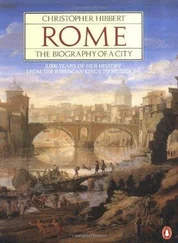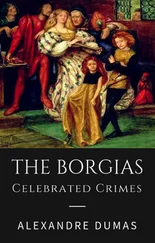With the issue of a wife for Cesare temporarily in abeyance, the pope now concentrated his efforts on finalizing the annulment of his daughter’s marriage. Under pressure from his uncles Duke Ludovico and Cardinal Ascanio, Giovanni Sforza finally gave way. ‘If His Holiness wants to create his own kind of justice,’ he declared, ‘there is nothing I can do about it; let the Pope do what he likes, but God watches over all things.’ On November 18 he reluctantly put his signature to the humiliating declaration: ‘I never knew her.’
A month later the marriage was dissolved. The demure Lucrezia was present at the ceremony in the Vatican on December 22 that formally declared her to be virgo intacta and, as such, legally able to contract another marriage. She gave a short speech of thanks in Latin, which the Milanese ambassador praised for its elegance: ‘If she had been Cicero himself,’ he mused, ‘she could not have spoken with more grace.’ But most of Rome, still buzzing with the rumours of her incestuous relationships with her father and brother, agreed with the Perugian chronicler Francesco Matarazzo, who thought the declaration that Lucrezia was a virgin to be a proposition so outlandish that it ‘set all Italy laughing,’ since it was, he explained with characteristic hyperbole, ‘common knowledge that she had been and still was the greatest whore there had ever been in Rome.’ She was, in fact, by this time, six months pregnant, though her ladies-in-waiting had dressed her carefully, to ensure that there were no visible signs of her condition.
In the convent of San Sisto, while her husband was being pressed to sign the required admission of his impotence, Lucrezia had received regular visits from a good-looking young Spaniard, a valet in her father’s service, one Pedro Calderon, to whom she seems to have become passionately attached; and on March 15, 1498, according to the reports of the Ferrarese ambassador in Venice, she gave birth to a boy.
When Cesare heard of Calderon’s guilt, so it was rumoured, he was determined to punish the valet for what he took to be his intolerable presumption. Finding him one day near Lucrezia’s room in the Vatican, after her return from the convent, he rushed at the man, brandishing his sword. Calderon ran away, seeking to escape the violent Cesare by throwing himself into the arms of Alexander VI, who threw his papal robe about the young man. But Cesare slashed at him with his sword, splashing his father’s robes with blood. A month before the boy was born, the body of Calderon was fished out of the Tiber, together with that of Lucrezia’s maid, Pantiselia. As the papal master of ceremonies Johannes Burchard recorded, he ‘fell, not of his own free will, into the Tiber and was fished up today in that river.’
Lucrezia’s baby seems to have been stillborn or to have died soon after birth, in what would become a sad and familiar end to her pregnancies. At about this time, confusingly, another Borgia child appeared in the Vatican and was christened Juan, in memory of the murdered Duke of Gandía. Endeavouring to explain Juan’s existence, the pope issued two bulls, one of them secret. The official bull declared that the child, delicately described therein as ‘the Roman infant’ ( infans Romanus ), was the son of Cesare Borgia by an unnamed spinster; the secret bull, on the other hand, maintained that the child was that of Alexander VI himself by the same unnamed spinster. The child was undoubtedly his, conceived while he was pope, but it was the identity of the spinster that caught the imagination of the Roman gossips; given the widely believed rumours that incest was rampant among the Borgias, it was perhaps inevitable that she was quickly identified as the pope’s own daughter (though Lucrezia herself would always consider Juan as her half-brother, as would later historians).
Meanwhile, arrangements for Lucrezia’s Neapolitan marriage went ahead, and Alexander VI agreed to provide the sum of 40,000 ducats for his daughter’s dowry, a third more than he had paid for her marriage to Giovanni Sforza. On July 21, 1498, Lucrezia and Alfonso, Duke of Bisceglie, were formally pronounced man and wife in a private ceremony, held ‘without pomp,’ according to Burchard, in Lucrezia’s palace at Santa Maria in Portico, where, in the presence of various ecclesiastics including several bishops and three cardinals, a sword was held over the heads of the bride and bridegroom.
The couple — he a good-looking, lively young man, she still a pretty, high-spirited girl — consummated their marriage and spent the next few days feasting and dancing. A fight between Cesare’s servants with those of Sancia marred the decorum of the wedding festivities but did not altogether spoil them. Cesare himself, still a cardinal, caused considerable surprise and, no doubt, ironical amusement by appearing with his brothers and courtiers in a masque dressed in the guise of a unicorn, the horned emblem of female chastity.
However, even while the Neapolitan alliance was being celebrated in Rome, the storm clouds were gathering on the Italian horizon. On April 7, 1498, the young King Charles VIII had died, very suddenly, after striking his head on a door lintel at the château of Amboise. He was just over a month short of his twenty-eighth birthday and had been married for over six years; his wife, Anne of Brittany, had borne him four children but none had survived infancy, and so the crown passed to his cousin, the thirty-six-year-old Louis, Duke of Orléans.
Eight days before he died, Charles VIII had seen a great serpent in his dreams, and when asked what this meant, his astrologers had replied that it was a sign that he would return to Italy. But after his death, reported the Venetian diarist Marin Sanudo, ‘the said astrologers changed their minds, saying that the serpent meant that he would be succeeded by the Duke of Orléans, as has happened, because the Duke carries this emblem on his coat-of-arms.’ The serpent on his shield was the Visconti viper: Louis was the legitimate heir of the old regime that had ruled Milan before the Sforzas had seized power, and he intended to enforce his claim.
— CHAPTER 13 — The Unwanted Cardinal’s Hat
‘HIS MIND AND HIS DESIRE AND HIS INCLINATION WERE STILL FOR THE SECULAR LIFE’
TALL IN STATURE, with a long face and a grave countenance, the new French king, Louis XII, was certainly more regal in appearance than his ugly predecessor; after a misspent youth, he had settled into middle age, devoting his time to hunting and falconry. At his unexpected succession to the French throne, he had several reasons for negotiating an early alliance with the Borgia pope.
Louis XII needed Alexander VI’s support to enforce his claim to the duchy of Milan; as the legitimate grandson of Valentina Visconti, daughter of the great Duke Gian Galeazzo, he had a better right to the title than the current duke, Ludovico Sforza, brother of Cardinal Ascanio, whose ancestors had been born on the wrong side of the blanket (Ludovico had inherited the title in 1494 at the death of his nephew, Gian Galeazzo, which, so it was said, had been ‘provoked by an immoderate coitus’). Louis XII also intended to revive the French claim to Naples, which Charles VIII had failed to retain after his conquest of the kingdom three years earlier. More pressing, however, was the king’s need for a divorce from his hunchbacked and barren wife, and for a papal dispensation that would allow him to marry Charles VIII’s widow, Anne of Brittany, not only to retain that troublesome region for the French realm but also to produce an heir.
In return for the dissolution of his marriage, as well as a cardinal’s hat for his trusted friend and councillor Georges d’Amboise, the archbishop of Rouen, Louis XII devised an offer that neither Alexander VI nor the ambitious Cesare could refuse. In addition to a handsome sum of money, the king proposed to give Cesare the duchy of Valence and to bestow upon him the coveted collar of the French royal chivalric Order of St Michael. He also offered to use his influence to arrange Cesare’s marriage to Carlotta of Aragon, daughter of the king of Naples and lady-in-waiting to Anne of Brittany. Moreover, providing Cesare agreed to fight with the French army during his forthcoming campaign to oust the Sforzas from Milan, Louis XII promised to give him the command of a large body of armed French lancers, which would be maintained at the king’s expense but would serve under Cesare’s command, wherever, significantly, the new duke wished.
Читать дальше











